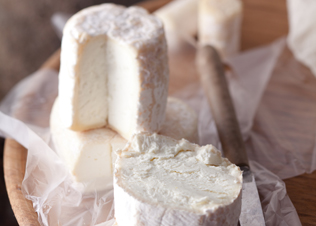News
Winner profile: Pépé Charlot Cheese Maker
Friday, April 19th, 2013
For the man behind Pépé Charlot Cheese Maker, the winner of the 2013 Eat Out DStv Food Network Produce Award in the dairy (cheese) category, it’s all about passion.
Pépé Charlot Cheese Maker was started by Frenchman Gerald Tanesse in September 2010 from a small kitchen in his home. After a year, the business moved into a cottage in Craighall Park refurbished with the cheesery in mind.
The history
The name Pépé Charlot means ‘Grandfather Charles’, and it was inspired by Gerald’s childhood in France. He was born in Lyon and used to go on summer holidays in Ardèche with his grandparents.
“With my grandfather, Pépé Charlot, I used to eat goat’s cheese for breakfast, lunch and dinner. He is the one who planted the seed in me, which today has become a passion for this particular type of cheese.”
Pépé Charlot used to buy several fresh goat’s cheeses at the market once a week and mature them in the cellar. Gerald explains, “He placed them in a fromager, a wooden box hung from the ceiling and covered with mesh to allow air to go through, but not the insects – in particular, the flies.
“And every day, several times, he would turn them, touch them to test their firmness and/or softness, taste them, and talk to them.”
This passion had interesting consequences for Gerald. Some of his grandfather’s cheeses were so hard that you couldn’t chew, only suck them. “Before going fishing (another passion of his), he used to break a piece of cheese and put it in my mouth instead of a sweetie. I sucked the thing for hours, getting used to its very particular taste. It never left me.
“When asked what I wanted to do later in life, I used to say, ‘I’ll be a milkman’.”
Almost 40 years later, after many odd jobs, Gerald finally realised his childhood dream and became a cheesemaker, producing the same cheese as he enjoyed as a child.
The cheesemaking process
When he bought the small cheesemaking business, he learnt two recipes from the previous owners. Since then, Gerald has been to France several times – and still goes every year – to learn new recipes.
“I started on my own, and then trained Steven, who is now in charge of the production. We do the maturation together and I do all the marketing, tasting and deliveries myself.”
Gerald buys milk from the University in Pretoria, where students are taught how to run a farm and feed the animals. He goes there twice a week to collect the raw milk in 20-litre plastic buckets.
“I don’t pasteurise the milk, as I believe that nature takes care of itself, and our recipes are very simple and non-intrusive,” Gerald says. “We do not cook the curd; we do not add flavour, herbs or other garnishes. Our cheese is fresh milk, slowly turned into cheese and matured.”
Production of the fresh cheese takes about four days. “Then we place the cheeses in two types of fridges. Some are cold and dry, while the others are moist and warm – this is where maturation takes place.” Maturation takes 17 to 21 days and consists of turning or moving the cheeses every day, to make them either drier and colder, or softer and warmer.
“We observe them, touch them, taste them; we take care of them, nursing them like little injured birds. And when they are ready, they go to restaurants.”
Some of the country’s top chefs are Gerald’s clients (see list below), and they serve the cheese in platters and incorporate them into dishes, salads, gratins, cheesecakes and other culinary delicacies.
“And the memory of my grandfather Pépé Charlot lives on.”
Big cheeses – the top products
Of the cheeses submitted for judging, the judges were particularly impressed with the Pépé, Crotin and the Buche Affinée.
Pépé is a typically French cheese. Soft and creamy, it has been matured for four to six weeks, and comes in a heart shape. Gerald created this one by adjusting a fresh farm-cheese recipe.
Crotin is a very famous and common French cheese. A bit stronger and drier, and matured for four to six weeks, this is the cheese used in France to make warm goat’s cheese salad. You place a slice of crotin on a piece of baguette, grill it, and then serve it with a green salad with a mustardy dressing. “You eat the warm cheese and bread with the cold salad – you will never see salad with the same eyes!” enthuses Gerald. If left to dry, the crotin becomes hard and can be grated like a parmesan.
Lastly, the shape, size and texture of the Buche Affinée make this an everyday cheese that you can spread on a baguette or grill on a ciabatta rubbed with a bit of garlic, and then drizzle in olive oil. Good from four to five weeks, this cheese can mature for up to 10 weeks and becomes creamier and tastier as it ages.
Where to buy Pépé Charlot cheese
Have your cheese and eat it at the Neighbourgoods Market, Bryanston Organic and Natural Market, the Bamboo Market in Melville, the Blubird whole food market, the Fourways farmers Market near Montecasino, Cheese Gourmet, Service Station, and Elbows Up Deli, the Craighall Park Spar.
Where to eat Pépé Charlot cheese
In Gauteng
Five Hundred at the Saxon, Corner Café, Eatery JHB, Warm and Glad, The Leopard, Moemas, Assaggi, La Cucina di Ciro, Café Picobella, Junipa’s, Restaurant Mosaic at the Orient, and Lucky Bread Company (the retail outlet of another produce awards winner, The Bread Gypsy).
In Cape Town and the winelands
Le Quartier Français, The Test Kitchen and The Pot Luck Club.
In KwaZulu-Natal
Hartford House.
Visit www.pepecharlot.co.za, email sales@pepecharlot.co.za or call Call 083 333 9418 for more information.












